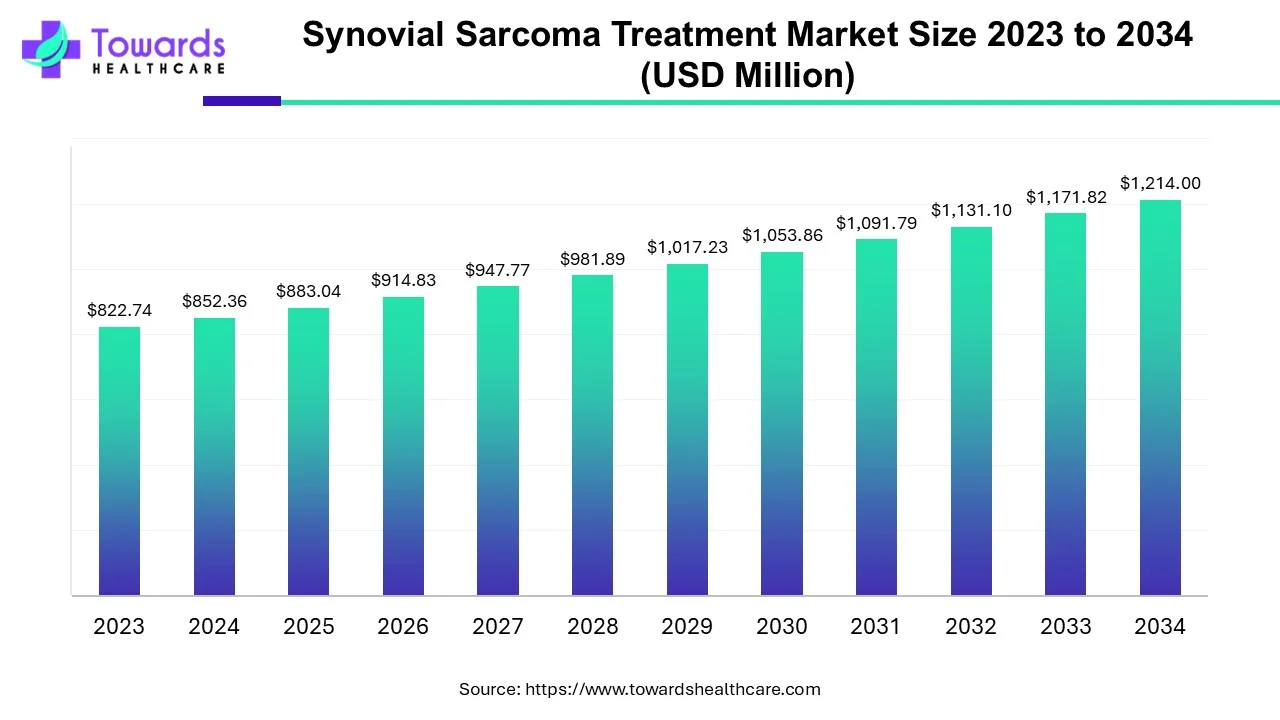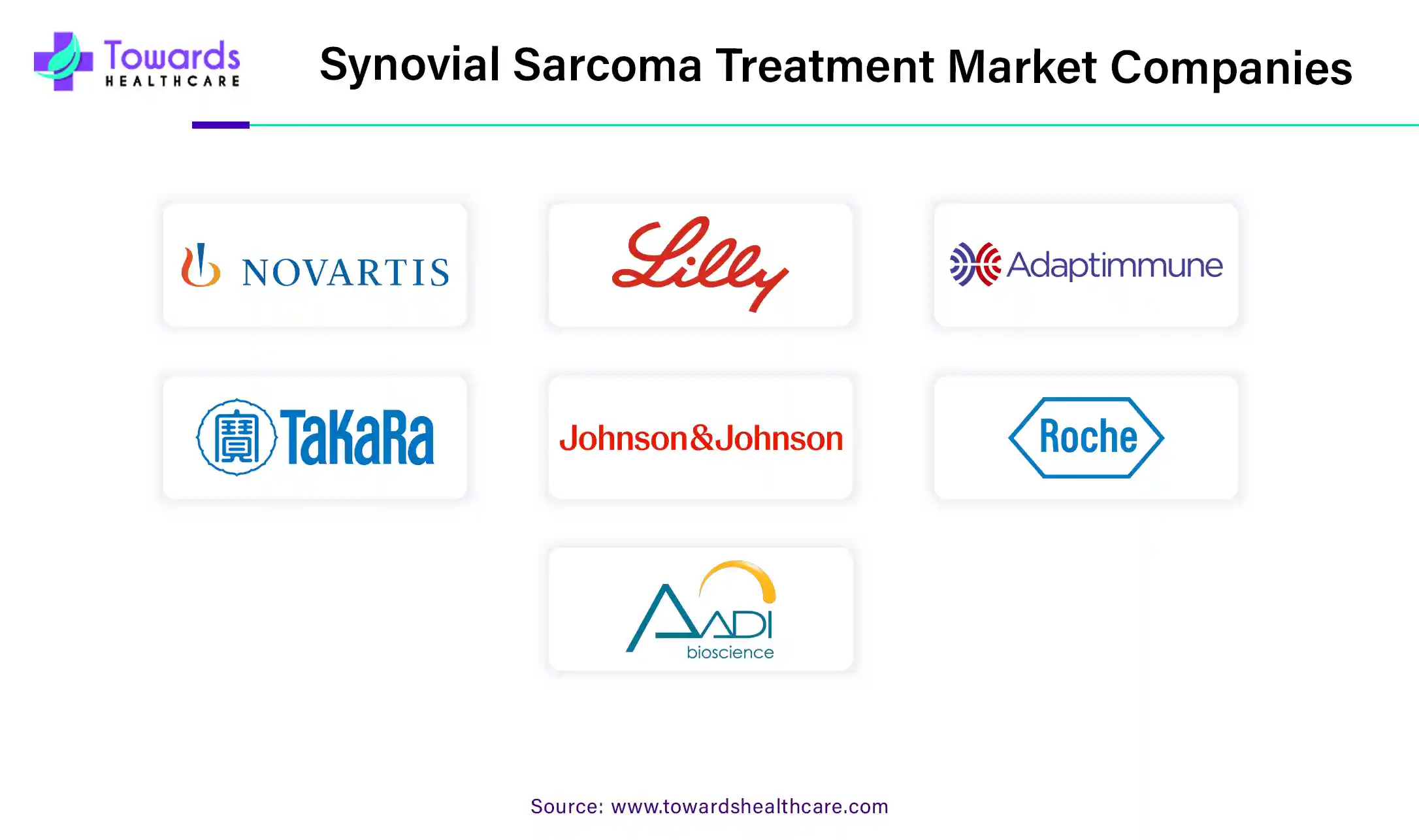December 2025

The synovial sarcoma treatment market is expected to grow from USD 883.04 million in 2025 to USD 1214 million by 2034, with a CAGR of 3.6% throughout the forecast period from 2025 to 2034.

According to the National Institute of Health, synovial sarcoma, a type of mesenchymal tumor commonly diagnosed in individuals under the age of 30, requires appropriate treatment for management. As the occurrence of synovial sarcoma rises, there is an increasing demand for innovative therapies to address this medical need.
Synovial sarcoma is a type of cancer that typically affects young adults and teenagers. It starts in the soft tissues, like muscles or tendons, usually around the joints in the arms or legs. Despite its name, it doesn't develop from the synovium, which is the lining of joints. Instead, it gets its name because, under the microscope, it looks similar to cells found in the synovium. Synovial sarcoma can be aggressive and may spread to other parts of the body. It's often treated with a combination of surgery, chemotherapy, and radiation therapy. Early detection and treatment are essential for better outcomes.
Report From National Institute of Health
Synovial sarcoma is crucial to treat and diagnose early because early detection and treatment can significantly improve outcomes. This type of cancer can grow and spread rapidly if left unchecked, making it harder to treat as it progresses. By catching synovial sarcoma early, doctors can intervene before it spreads to other body parts, making treatment more effective and increasing the chances of successful recovery. Additionally, early diagnosis allows for less invasive treatment options, reducing the potential for complications and improving the quality of life for patients. Therefore, it's essential to seek medical attention promptly if there are any signs or symptoms suggestive of synovial sarcoma to ensure the best possible outcome.
For instance,
The market for synovial sarcoma treatment is expected to increase because more cases of this type of cancer are being diagnosed. As our understanding of the disease improves, doctors can better identify and treat it. Additionally, advances in medical research and technology are leading to the development of more effective treatments. As a result, a growing demand for medications, therapies, and medical services related to synovial sarcoma drives the market's growth.
The American Cancer Society projects that in 2024, approximately 13,590 new cases of soft tissue sarcomas will be diagnosed in the United States. Among these cases, around 7,700 are expected to occur in males and 5,890 in females. Additionally, it is estimated that about 5,200 individuals will succumb to soft tissue sarcomas, with approximately 2,760 males and 2,440 females losing their lives to this type of cancer.
The increasing number of synovial sarcoma diagnoses creates a pressing demand for effective treatments. Imagine a scenario where a popular toy suddenly becomes highly sought after – to meet the market, and stores ramp up production.
Synovial sarcoma, the growing patient population, drives the need for more treatment options. This spurs doctors and scientists into action, prompting intensified efforts to develop innovative medicines and therapies personalized to combat the cancer's specific characteristics. With more patients seeking treatment, pharmaceutical companies and hospitals recognize the market potential and invest heavily in research and development.
For instance,
This influx of resources fuels advancements in understanding the disease and creating new treatment modalities. As a result, the cycle continues: more diagnoses lead to more significant investment in research, yielding more treatment options. Ultimately, this iterative process drives the growth of the synovial sarcoma treatment market, ensuring patients have improved access to the care they urgently need.
Researchers are deeply invested in unraveling the complexities of synovial sarcoma, meticulously examining its intricate components to understand how the disease operates at its core. This profound understanding is the foundation for developing targeted treatments, akin to crafting a precisely fitting key to unlock a door, where these therapies are designed to attack cancer cells while sparing healthy tissue selectively.
Additionally, the advent of personalized medicine allows for the customization of treatments to suit the individual characteristics of each patient, resembling customized-made personalized clothing to fit perfectly. Concurrently, ongoing research efforts drive the development of novel drugs customized specifically to combat synovial sarcoma, broadening the spectrum of available treatment options and potentially enhancing patient outcomes and quality of life.
For instance,
Furthermore, specific treatments directly assail cancer cells and bolster the body's inherent defense mechanisms against the disease, offering an additional layer of protection. Clinical trials play a pivotal role in evaluating the safety and efficacy of these emerging treatments, providing invaluable data to refine and further develop therapeutic strategies while attracting essential funding for continued research endeavors. This relentless pursuit of understanding and innovation in synovial sarcoma treatment holds immense promise for improving patient outcomes and propelling advancements in the field.
For instance,
Chemotherapy is essential for treating synovial sarcoma, and it helps the market for these treatments in a few ways. First, it's often the primary treatment doctors use, especially when surgery or radiation isn't an option. So, there's always a need for chemotherapy drugs, which keeps the market going strong.
Additionally, chemotherapy is often used alongside other treatments like surgery or radiation to lower the chances of the cancer coming back. This makes chemotherapy a crucial part of overall treatment plans. When synovial sarcoma has spread or can't be cured, chemotherapy is used to help manage symptoms and make patients feel better. This means there's always a demand for these drugs, even if they can't cure the cancer.
Combining different types of treatments for cancer is showing promise in trials
Because there's a significant demand for better chemotherapy drugs, pharmaceutical companies keep working on new ones. This helps expand the market by giving patients more options for treatment. Furthermore, ongoing research studies, called clinical trials, test out new chemotherapy treatments. If these trials show positive results, it could lead to new drugs being approved and more choices for patients.
The need for more awareness about synovial sarcoma among the general public and healthcare providers is a big problem. Because this type of cancer is rare, many people don't know about it, and doctors might not think of it right away when someone has symptoms. This can lead to delays in getting the correct diagnosis and treatment. Additionally, doctors must become more familiar with synovial sarcoma to send patients to specialists who can help. This lack of awareness can also make it harder for researchers to get funding to study the disease and develop new treatments. Furthermore, not knowing enough about synovial sarcoma could slow down the expansion of its treatment market.
For instance,
People with synovial sarcoma might feel alone and misunderstood because not many people know about their condition. We need more education and training programs to help spread the word about synovial sarcoma so people can get diagnosed early, get the proper care, and researchers can find better treatments.
North America's market for treating synovial sarcoma is expected to grow the most in revenue in the coming years. This is because many important companies are making the needed products, and there's a lot of research and spending on healthcare. Also, more people are getting diagnosed with synovial sarcoma in this region. It's not a common type of cancer, with only about one to two people out of every million in the U.S. getting diagnosed with it each year. The Sarcoma Foundation of America and the Synovial Sarcoma Research Foundation are also helping by providing funds for new treatments and therapies, which adds to the market's growth. Additionally, the number of obese people and older folks in places with advanced economies is expected to increase, leading to more patients needing treatment.
The market for treating synovial sarcoma in Asia-Pacific is expected to grow steadily. This growth is because there are more hospitals and clinics, people are learning more about cancer, and medical technology is improving. Additionally, because there are so many people in this region, there are a lot of potential patients. However, some countries don't have as many advanced treatments, and people there don't spend as much on healthcare, which might slow the market's growth. Governments and healthcare groups are working to improve cancer care and give more people access to treatments, which should help the market grow.
Different companies are competing to offer the most effective treatments in the synovial sarcoma treatment market. They spend money on research to make new drugs or make the ones they have better. According to the National Library of Medicine, using both doxorubicin and ifosfamide together is the primary treatment for synovial sarcoma. If patients can't use doxorubicin, they might get only ifosfamide at a higher dose. This can also work for patients who have already had ifosfamide before. They also work hard to tell people about their treatments so more patients and doctors know about them. Sometimes, these companies collaborate with hospitals or research groups to improve treatments and reach more people. This competition pushes them to develop new ideas and better treatments, which helps patients get the best care possible.

By Treatment Type
By End User
By Geography
December 2025
December 2025
November 2025
November 2025